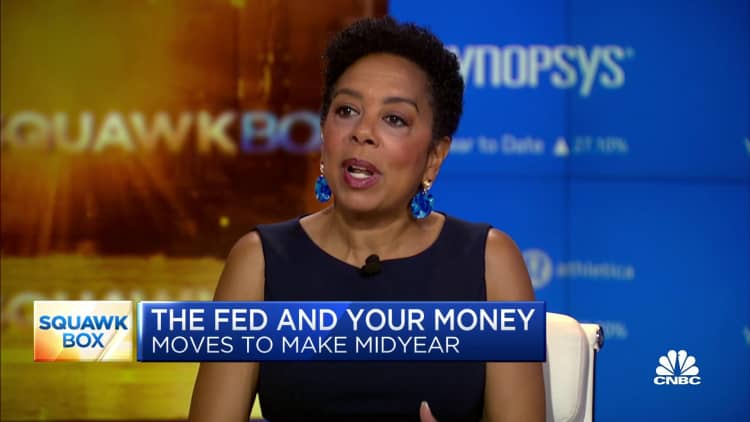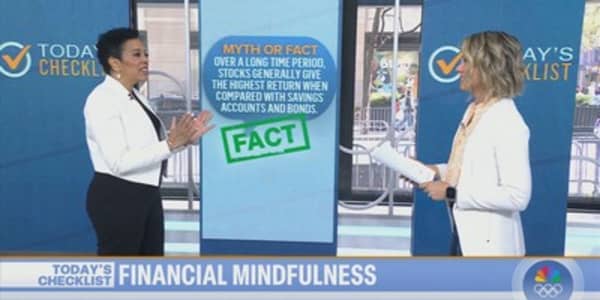
The Federal Reserve raised the target federal funds rate by a quarter of a point Wednesday, in its continued effort to tame inflation.
In a move that financial markets had completely priced in, the central bank's Federal Open Market Committee raised the funds rate to a target range of 5.25% to 5.5%. The midpoint of that target range would be the highest level for the benchmark rate since early 2001.
After holding rates steady at the last meeting, the central bank indicated that the fight to bring down price increases is not over despite recent signs that inflationary pressures are cooling.
For now, inflation remains above the Fed's 2% target; however, "it's entirely possible that this could be the last hike in the cycle," said Columbia Business School economics professor Brett House.
What the federal funds rate means to you
The federal funds rate, which is set by the U.S. central bank, is the interest rate at which banks borrow and lend to one another overnight. Although that's not the rate consumers pay, the Fed's moves affect the borrowing and saving rates consumers see every day.
This hike — now the 11th interest rate increase since March 2022 — will correspond with a rise in the prime rate and immediately send financing costs higher for many forms of consumer borrowing, putting more pressure on households in hopes of sidestepping a possible recession.
"The pain that the rate hike has caused for a lot of people isn't gratuitous," House said. "Ultimately, this is a trade off in choices between pain now and greater pain later if inflation isn't brought under control."
How higher interest rates can affect your money
1. Credit card rates are at record highs
Since most credit cards have a variable rate, there's a direct connection to the Fed's benchmark. As the federal funds rate rises, the prime rate does, as well, and credit card rates follow suit within one or two billing cycles.
The average credit card rate is now more than 20% — an all-time high, while balances are higher and nearly half of credit card holders carry credit card debt from month to month, according to a Bankrate report.
Altogether, this rate hike will cost credit card users at least an additional $1.72 billion in interest charges over the next 12 months, according to an analysis by WalletHub.
"It's still a tremendous opportunity to grab a zero percent balance transfer card," said Greg McBride, Bankrate's chief financial analyst. "Those offers are still out there and if you have credit card debt, that is your first step to give yourself a tailwind on a path to debt repayment."
2. Mortgage rates will stay high
Because 15- and 30-year mortgage rates are fixed and tied to Treasury yields and the economy, homeowners won't be affected immediately by a rate hike. However, anyone shopping for a new home has lost considerable purchasing power, partly because of inflation and the Fed's policy moves.
The average rate for a 30-year, fixed-rate mortgage currently sits near 7%, according to Freddie Mac.
Since the coming rate hike is largely baked into mortgage rates, homebuyers are going to pay roughly $11,160 more over the life of the loan, assuming a 30-year fixed rate, according to WalletHub's analysis.
Other home loans are more closely tied to the Fed's actions. Adjustable-rate mortgages, or ARMs, and home equity lines of credit, or HELOCs, are pegged to the prime rate. Most ARMs adjust once a year, but a HELOC adjusts right away. Already, the average rate for a HELOC is up to 8.58%, the highest in 22 years, according to Bankrate.
3. Car loans are getting more expensive
Even though auto loans are fixed, payments are getting bigger because the price for all cars is rising along with the interest rates on new loans. So if you are planning to buy a car, you'll shell out more in the months ahead.
The average rate on a five-year new car loan is already at 7.2%, the highest in 15 years, according to Edmunds.
The double whammy of relentlessly high vehicle pricing and daunting borrowing costs is presenting significant challenges for shoppers.Ivan Drurydirector of insights at Edmunds
Paying an annual percentage rate of 7.2% instead of last year's 5.2% could cost consumers $2,278 more in interest over the course of a $40,000, 72-month car loan, according to data from Edmunds.
"The double whammy of relentlessly high vehicle pricing and daunting borrowing costs is presenting significant challenges for shoppers in today's car market," said Ivan Drury, Edmunds' director of insights.
4. Some student loans are pricier
Federal student loan rates are also fixed, so most borrowers aren't immediately affected by the Fed's moves. But as of July, undergraduate students who take out new direct federal student loans will pay an interest rate of 5.50%, up from 4.99% in the 2022-23 academic year.
For now, anyone with existing federal education debt will benefit from rates at 0% until student loan payments restart in October.
Private student loans tend to have a variable rate tied to the Libor, prime or Treasury bill rates — and that means that, as the Fed raises rates, those borrowers will also pay more in interest. But how much more will vary with the benchmark.
What savers should know about higher rates
The good news is that interest rates on savings accounts are also higher.
While the Fed has no direct influence on deposit rates, they tend to be correlated to changes in the target federal funds rate. The savings account rates at some of the largest retail banks, which have been near rock bottom during most of the Covid pandemic, are currently up to 0.42%, on average.
Thanks, in part, to lower overhead expenses, top-yielding online savings account rates are now at more than 5%, the highest since 2008′s financial crisis, with some short-term certificates of deposit even higher, according to Bankrate.
However, if this is the Fed's last increase for a while, "you could see yields start to slip," McBride said. "Now's a good time to be locking that in."






